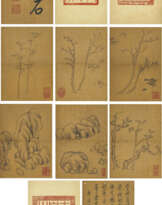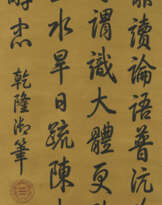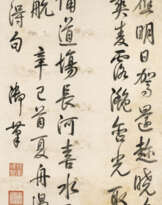ID 1086675
Lot 832 | EMPEROR QIANLONG (1711-1799, REIGNED 1736-1796)
Estimate value
HKD 3 000 000 – 5 000 000
Replanted Wutong Studio
Scroll, mounted and framed, ink on paper
145 x 69 cm. (57 1⁄8 x 27 1⁄8 in.)
Inscribed and signed, with nine seals of the artist
Dated summer, fifteenth day, fourth month, jiazi year (1744)
Nineteen colophons dated 1745 to 1781, with a total of thirty-one seals of the artist
One illegible colophon, with two seals of the artist
Colophons by Wang Youdun (1692-1758) and Dong Bangda (1699-1769), with a total of four seals
Further details
The Flamboyant King: Emperor Qianlong’s Artistry and Poetic Aspiration in the Replanted Wutong Studio
Characterized as a debonair ruler, Emperor Qianlong is famous for his untrammeled spirit and affectionate vigour. In his spare time from the myriad of state affairs, he delightfully practiced the four arts: music, chess, calligraphy and painting. He ordered the compilation of Treasures of the Stone Canal Pavilion (Shiqu Baoji) for the paintings and calligraphy, The Xiqing Compilation of Antiquities for ancient ritual bronzes and The Emperor’s Rare Books for original manuscripts of great classical literature. Such cultural triumph symbolises the successful civilian governance and prosperous military achievements during the Qianlong period. The Replanted Wutong Studio not only captures a moment of historical grandeur, but also conveys the emperor’s sentiment on the changing and passing of things.
In 1724, the crown prince Hongli (Emperor Qianlong’s birth name) studied at the Southern Pavilion on the Yingtai Island of the South Lake, with two wutong trees in the courtyard. In 1744, one of them died over the winter. The emperor ordered to replant a new one and composed Imperial Poem dedicated to the Replanted Wutong Studio to express his sadness. The last two lines read ‘Silently stands the wutong tree, life in a flash; I have as though traveled twenty years back, pondering the right words for a poem.’ The emperor was in search of the lost time.
In 1745, using the wood of the withered wutong tree, the Emperor Qianlong ordered to make four qins, namely Holy Sounds from the Yingtai Island, Blue Autumn Sky above the Xiang River, Bird’s Cry on the Frosty Meadow and Love Drifts on the Sea of Clouds, each inscribed with his poem and preciously kept in the studio. In 1747, he dedicated two more poems to the wutong tree. In the poem of 1749 there is a line that says ‘Every time I write a new line to connect an old one’ where its underneath has a note: ‘I used to hang the Replanted Wutong Studio painting on the wall. Through the years, whenever the verses came into my mind, I repeatedly inscribed them on it.’ (See Qingding rixia jiuwen kao, vol. 22, p. 293). This proves to be conclusive with the inscriptions on this painting.
From 1745 to 1786, Emperor Qianlong had inscribed 24 poems on which the upper part of the Replanted Wutong Studio was punctiliously filled up. One can imagine when the impressive Replanted Wutong Studio was hung in the room, the emperor was reconnected to the past and then expressed his sentiments through poems, ink and brush over the course of 41 years.
At the bottom right corner of this painting two poems were further inscribed by senior officials and imperial scholars Wang Youdun (1692-1758) and Dong Bangda (1699-1769). The interaction between the royal and civil hands on this masterpiece delivers a sense of unified virtuosity, and the emperor’s benevolent vision of sharing elegance and nobility with the people.
Dedication & Self-Improvement – The Liu Jing Xiu Tang Collection of Chinese Paintings
It was a sensation when Christie’s Hong Kong proudly presented the Liu Jing Xiu Tang Collection of Chinese Paintings in May 2013. This autumn, we are very honoured to present the second installment of this collection, comprising 21 Classical and Modern works that belonged to the illustrious industrialist - textile giant of modern China, Mr Liu Kuo Chun (1887-1978).
Born in Shengci town, Jingjiang city of Jiangsu province, Liu Kuo Chun studied briefly at private school at the age of 10. In 1901, he went to Changzhou to make a living and subsequently started a business in textile trading with a dye workshop. In 1916, he established Dalun Machine Weaving Factory with his partners and in 1918, he opened Guangyi Weaving Factory in sole proprietorship. In 1930, he set up Dacheng Textile Printing and Dyeing Co., Ltd. In 1938 he established Anda Textile Co. Ltd. in Shanghai and in 1948, he set up South Cotton Mill Ltd. in Hong Kong. He returned to China in 1950 and served as Chairman and General Manager of Dacheng Company, and Vice Chairman and Deputy General Manager of Anda Company. Later he served as a Deputy to the National People’s Congress, Vice Governor of Jiangsu Province, Vice Chairman of the Jiangsu Provincial Committee of the Chinese People’s Political Consultative Conference and Member of the Standing Committee of Jiangsu Provincial People’s Congress, to name but a few.
With a gift of discerning opportunities, a passion for advanced technology and management reform and a strength of horses for courses, Liu Kuo Chun eventually became the leader in the textile industry of the time. In 1941 he began acquiring paintings and calligraphy in Shanghai. He also attended exhibitions, where he met and made friends with collectors and connoisseurs such as Qian Jingtang (1907-1983), Wu Hufan (1894-1968), Xie Zhiliu (1910-1997) and Wang Nanping (1924-1985). Through their appreciation sessions from time to time, Mr Liu enhanced his knowledge on paintings and calligraphy. Later he acquired many works from private collections in Nanjing, Beijing, Chongqing , Hong Kong and Changzhou etc. that enriched the quality and quantity of the Liu Jing Xiu Tang Collection.
Named after Mr Liu’s motto ‘Dedication and Self-Improvement’, the Liu Jing Xiu Tang is one of the buildings in his former residence in Shengci town, Jingjiang city. Mr Liu not only had outstanding business achievements but also a strong sense of social responsibility. A philanthropist, he sponsored various charitable projects related to education, temple restoration, etc. Part of his paintings, calligraphy and furniture collection had been donated to various cultural institutions, including Nanjing Museum, Changzhou Museum, Changshu Museum and Jingjiang Archives, for sharing his love of art with the society.
| Artist: | Emperor Qianlong (1711-1799) |
|---|
| Artist: | Emperor Qianlong (1711-1799) |
|---|
| Address of auction |
CHRISTIE'S 18 Chater Road Central Hong Kong Hong Kong | ||||||||||||||
|---|---|---|---|---|---|---|---|---|---|---|---|---|---|---|---|
| Preview |
| ||||||||||||||
| Phone | +85227601766 | ||||||||||||||
| Fax | +852 2760 1767 | ||||||||||||||
| Conditions of purchase | Conditions of purchase | ||||||||||||||
| Business hours | Business hours
|



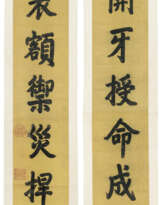
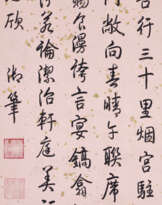
![[QIANLONG, Empereur de Chine (1711-1799) et Charles-Nicolas COCHIN (1715-1790), dir.]](/assets/image/picture_3601309/5c32d/rqfwcmyodhwl6a3u3cnvjqatap9yfxpvbnyt77bbuqb0bh1q4smembav9v5ika1700204263jpg__fix_162_205.jpeg)
